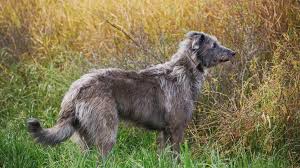Most will find that the Irish Wolfhound has a much more courageous, confident, and calm personality while the Scottish Deerhound is a lot gentler and polite. The Irish Wolfhound wouldn’t do well as a guard dog, but because of their patience, intelligence, and calmness would make a great addition and companion for a family with children.
Table of Contents
Scottish Deerhounds as Watch Dogs?
Scottish Deerhounds are very loyal and extremely affectionate with their families and typically prefer not to be left alone. They are rarely aggressive and respond well to strangers. This is definitely not a guard dog. Most deerhounds will do well with children when properly socialized, but as a large dog, it should not be left unsupervised around small children.
Are Scottish Deerhounds Aggressive?
Outline: Scottish deerhounds are predisposed to developing osteosarcoma (bone tumours). It has been estimated that more than 15% of animals of this breed become affected during their lifetime. The disease can occur at any age but the average age at diagnosis is 7. 7 years. It is an aggressively malignant form of cancer which causes almost 100% mortality unless successfully treated, and treatment is successful in only about 10% of cases. It causes severe and progressive pain which can be difficult or impossible to alleviate. The disease in Scottish deerhounds is associated with a single dominant gene. It seems likely that the prevalence may be reduced by breeding only from lines that do not have a history of the disease.
Scottish Deerhounds Background
Scottish deerhounds are considered to be at very high risk of osteosarcoma; it has been suggested that there is a prevalence of 150 cases per 1000 dogs in this breed (ie 15%). This is much greater than the background prevalence across all dog breeds, which is7 cases per 100,000 dogs (Dillberger 1996, Ru et al 1998).
Family and Bonding
The Scottish deerhound is mellow, low-key and easygoing — a gracious and well-mannered addition to the home. Outdoors, it loves to run and chase anything that moves. Indoors, it needs plenty of room to stretch on a soft surface. The deerhound is independent but willing to please; it is extremely sensitive. It is amiable toward, but often reserved with, strangers. This breed is good with children, other dogs and usually other pets, although it may give chase to strange animals.
Friendly
The breed is obedient, friendly and docile. They are willing and easy to train. Scottish Deerhounds should never be suspicious, aggressive or nervous.
Scottish Deerhound Nature
Is it all worth it? Of course! She’s full of personality, and you love her for it! The Scottish Deerhound is a proud and gentle giant. Her favorite game is chase, but after a good run she settles down indoors. Because of her nature, she makes a great family companion.
Intelligence
Wanting to get a Scottish Deerhound and need and wondering whether Scottish Deerhound is an intelligent dog breed?
According to pet experts, Scottish Deerhound Dogs score out of 5 in the scale of intelligent dog breeds.
Love
Scottish Deerhounds as a Pack Animal
Unlike what you might expect from a canine, Scottish Deerhounds do not hunt in packs. They often hunt by themselves or in pairs at the very most.
Physical Traits
Resembling a larger, coated Greyhound, the Scottish Deerhound is a keen and alert sight hound. One of the oldest breeds, the Deerhound possesses a preeminent hunting ability, and is often seen at lure coursing events. The hair on the body and neck is harsh and wiry, while the coat on the head, breast and belly is much softer. Known centuries ago as the Scotch Greyhound, Rough Greyhound and Highland Deerhound, the Scottish Deerhound became a clearly identified breed in the 16th and 17th centuries. He was the best breed to use for the pursuit and killing of deer, and at the time, could be owned by no one of rank lower than an earl. While he possesses a quiet and dignified personality in the home, the Scottish Deerhound may try to chase any furry animals that run past him. For that reason, the breed should be exercised on leash or in a fenced area. The breed’s crisp, somewhat wiry coat, however, is exceptionally easy-care, requiring only brushing and occasional bathing.

